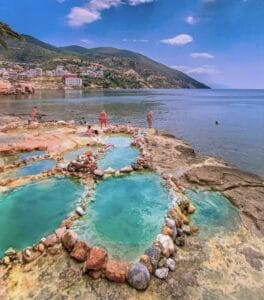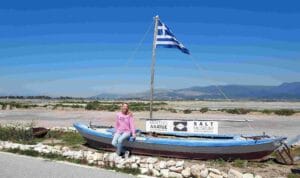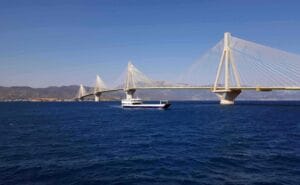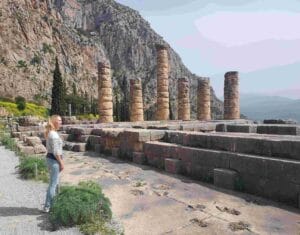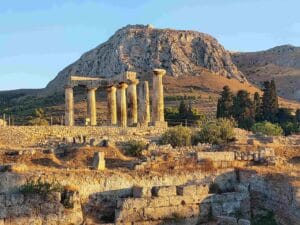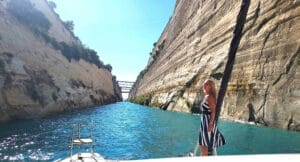After a great time in Cádiz for Christmas, we prepared ourselves for a milestone we have been looking forward to for a while: sailing through the Strait of Gibraltar!
There a several reasons why Gibraltar is such a milestone for us and for many sailors:
– it’s the connection point between the Atlantic Ocean and Mediterranean Sea. After having sailed the Atlantic for 8 months (since Mai 2022), with all the differences in tides (sometimes 8 to 11 meters!), the waves and being out in the open blue waters, it’s nice to come to the Med with quiet turquoise waters and hardly any tide differences!
– the Strait of Gibraltar is one of the busiest areas to sail with lots of cargo boats and oil tankers, in between 2 continents (Europe and Africa) and having a view on 3 countries (Spain, Morocco and Gibraltar).
– visiting the Rock of Gibraltar, with the apes who live in the wild. That must be exciting to see!

Preparation was important, especially in December which can cause rough conditions on the water. Our timing to sail away from Barbate, the city in Spain where we would start sailing to Gibraltar, would depend on:
– currents. In the Strait of Gibraltar, on the surface there is an eastward current to the Mediterranean (upstream). That’s positive. But there is an undertow, which is a deeper counter current from the heavier saltier water from the Mediterranean to the Atlantic. So you have to know when the tides are getting higher or lower (every 6 hours) to calculate back your starting time.
– windforce. It’s a narrow strait and on both sides are high mountains. Also on the African continent, the Moroccan coastline, only 15 kilometers away. This can make the wind blow strong through a kind of funnel. This is also why the Old Greeks called the strait between the two rocky capes ‘the Pillars of Hercules’, which marked the end of the world to them. According to them, the rocky capes would block oceanmonsters to enter the Mediterranean Sea. When the old Greeks came close to the Strait with their boats, the slogan was ‘Non plus ultra’ (no further).
– entrance instructions. Gibraltar is officiallyBritish Overseas Territory. So when sailing, you have to listen to the messages from the coastguards on your marifoon, knowing the right VHF channel is important here. Especially with the recent Brexit, there might be different legal rules for people entering from Europe (Spain) into Gibraltar.
We decided to leave early with the first sunrise (8.00h) from Spain, because in normal conditions it would take 7 hours sailing, in favorable conditions (current and wind) 5 hours, but setbacks like strong currents could make the trip last over 10 hours and you like to arrive at daylight in unknown territory. Our slogan in challenging sailing conditions is always: plan for the worst and hope for the best.
It turned out to be a very easy and relaxing sailing experience! The sun was shining, 22 degrees, mild wind from the west, the surface flow was in our favor: adding 3.6 knots of extra velocity to our sailing speed! And maybe because it was the 30th of December, it was very quiet in the Strait of Gibraltar with big boats on the water.



We could see the mountains of Morocco in the distance and even heard Arabic talks on the marifoon coming from Tangier!

After 3 hours, we saw the Rock of Gibraltar appearing. To my surprise it was much larger than I expected. In my imagination, it would be a small high rock, and sitting on top staring in the distance, Bokito (I’m from Rotterdam 😊). The Rock is 426 meters high and turned out to be 3,5 kilometers long and 2 km wide. It’s more like a peninsula.


Now we would sail into the Bay of Gibraltar, and come into British Overseas Territory. On the marifoon we heard many instructions from the British coast guard to the many big boats who lay there waiting in the bay for a good moment to sail into 1 of the 4 large (industrial) harbors to (un)load their cargo.

Suddenly we heard in civilized English over the marifoon: ‘Sailing vessel, sailing vessel, you are about to sail into British waters. State your intentions now, over’. Gilles: ‘We are here to invade your country’. I look to the left at Gilles in horror: what is he doing?? But I saw a big smile, Gilles was not talking in the marifoon to the British Customs official, the message was also not meant for our catamaran. ‘Yes, yes’, Gilles said to me ‘we are invading the country, the two of us’. We laughed and that took off some of the tension which is always there if you entering a new country with customs rules!
We came into the harbor at Gibraltar and spent a lovely 4 days at the peninsula!

The weather was great, so at New Years people walked in the streets in their sweaters. And typical English: wearing glitter hats and having more bang fireworks than decorative fireworks! We know about English New Year celebrating, because last year, we celebrated New Year (and Christmas) in Edinburgh. We never thought we would celebrate New Year 1 year later on British territory again!



It was funny to see all the English streets and shops: Main Street with pubs and all English food. Also funny shops like ‘Hungry monkey’ which is a pizza company. Of course we had a full English lunch at Gibraltar: bacon, scrambled eggs, sausage, baked beans, mushrooms, tomato, hash brown and toast.
Gibraltarians are with 30.000 people, most om them in the town at the foot of the rock at the headland. The currency is the Gibraltarian pound, but also the British Pound and Euro are accepted. I read that they drive on the right sight on the road, so no need for adjustment there for us. Also there is a Dutch link: Gibraltar was captured from Spain in 1704 during the War of the Spanish Succession by an Anglo-Dutch force. The area was then ceded under the Treaty of Utrecht to the Kingdom of Great Britain in 1713. It’s still a quarrel between Spain and Britain.



The border between Gibraltar and Spain is interesting! Because you have to cross customs (in our case with our bikes in between the waiting line with cars!) and you have to show your passports twice. Then you end up on the runway of Gibraltar airport! Because the only road between Spain and Gibraltar crosses the runway and must therefore be closed with barriers when an aircraft lands or takes off, which happens several times a day. The track has been stretched by extending it over the water. It was very interesting to cycle here looking left and right at the runway to see if a plane would land or take off!


There is a lot of British Military history here which you can see in the barracks in town and in the names of the streets. In the Rock there are many tunnels where about 16.000 soldiers could find shelter in World War II.
We visited the Rock by cable car and on the top you could see the harbors and the peninsula.



The Berber monkeys were walking around freely. It is a National Park and you are not allowed to feed or touch the monkeys. The colony consists of several hundred animals in six different groups. There were very relaxed and didn’t mind if you sat next to them or took a picture.



Legend has it that Gibraltar will remain in British hands as long as monkeys live on the rock. Partly for this reason, the population is strictly protected. Winston Churchill even had new monkeys imported from North Africa during World War II because the population had shrunk to seven animals.



We found the atmosphere in Gibraltar cozy and friendly. We still had our Christmas decoration inside and outside the boat (Gilles insisted to keep them until his birthday the 10. January!) and we got many compliments (‘I love your lights!’).
On the day we left Gibraltar, we filled our tanks with diesel because Gibraltar is taxfree. We paid € 1,24 per liter, which is far cheaper than the € 1,74 we paid last time in Spain! And we have 2 tanks with each 300 liters, so that € 0,50 per liter ‘discount’ is very welcome! Also interesting, the fuel berth is next to the airport, you can almost touch the runway! So when you want to go there with your sailing vessel, you have to call the British coastguard with your marifoon and ask permission to sail in. Because if your mast is higher than 10 meters and a plane wants to take off, it might hit your boat, it is that close to the runway! When we filled up our dieseltanks, a plane landed next to us, which was very close by and very loud!
So after that, we ‘rounded’ the cape of Gibraltar, on to the Mediterranean Sea! We will write about our first experiences next time!

